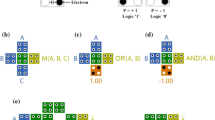Abstract
Multiple-valued logic such as ternary logic has attracted the digital system designers attention in recent years as it offers the benefits of reduced interconnects, higher operating speeds and smaller chip area. A goal of multi-threshold circuit design could be easily achieved by incorporating the scalable threshold voltage values of carbon nanotube field effect transistors (CNTFETs). This paper proposes a novel design of low-power and high-performance ternary adder and subtractor circuit design by combining the futuristic ternary and conventional binary logic design approaches. The simplified design of ternary to a binary decoder based on negative ternary inverter and positive ternary inverter outputs, and further transmission gate-based ternary multiplexer implementation facilitates the low power consumption and energy efficiency in the implementation of the complex arithmetic circuits. Extensive HSPICE simulations are conducted with the standard 32 nm CNTFET technology in order to evaluate the performance metrics of the realized circuits. According to the simulation results, proposed ternary adder and subtractor cells show the significant improvement in energy consumption (PDP) as compared to their counterparts under different test conditions. Moreover, the ripple adder structure is realized using the proposed adder circuit in order to test the practicability of given circuits in cascaded structures.

















Similar content being viewed by others
References
P.C. Balla, A. Antoniou, Low power dissipation MOS ternary logic family. IEEE J. Solid State Circuits 19(5), 739–749 (1984)
N.H. Bastani, M.H. Moaiyeri, K. Navi, Carbon nanotube field effect transistor switching logic for designing efficient ternary arithmetic circuits. J. Nanoelectron. Optoelectron. 12(2), 118–129 (2017)
K.Y. Bok, Y.B. Kim, F. Lombardi, Novel design methodology to optimize the speed and power of the CNTFET circuits, in Proceedings of the IEEE International Midwest Symposium on Circuits and Systems, Cancun, Mexico (2009), pp. 1130–1133
J.T. Butler, Multiple-Valued Logic in VLSI Design, IEEE Computer Society Press Technology Series. Los Alamitos, California
G. Cho, Y. Kim, F. Lombardi, M. Choi, Performance evaluation of CNFET-based logic gates, in Proceedings of the IEEE International Instrumentation and Measurement Technology Conference, Singapore (2009), pp. 909–991
J. Deng, H.S.P. Wong, A compact SPICE model for carbon-nanotube field-effect transistors including non idealities and its application—part I: model of the intrinsic channel region. IEEE Trans. Electron Device 54(12), 3186–3194 (2007)
J. Deng, H.S.P. Wong, A compact SPICE model for carbon-nanotube field-effect transistors including non-idealities and its application—part II: full device model and circuit performance benchmarking. IEEE Trans. Electron Device 54(12), 3195–3205 (2007)
A. Dhande, V. Ingole, Design and implementation of 2 bit ternary ALU slice, in Proceedings of the International Conference IEEE-Sciences of Electronic, Technologies of Information and Telecommunications (2005), pp. 17–21
S.A. Ebrahimi, P. Keshavarzian, S. Sorouri, Low power CNTFET-based ternary full adder cell for nanoelectronics. Int. J. Soft Comput. 2(2), 291–295 (2012)
F. Jafarzadehpour, P. Keshavarzian, Low-power consumption ternary full adder based on CNTFET. IET Circuits Devices Syst. 10(5), 365–374 (2016)
S. Karmakar, J. Chandy, F. Jain, Design of ternary logic combinational circuits based on quantum dot gate FETs. IEEE Trans. VLSI Syst. 21(5), 793–806 (2013)
Y.B. Kim, Challenges for nanoscale MOSFETs and emerging nano-electronics. Trans. Electr. Electron. Mater. 11(3), 93–105 (2010)
Y. Lin, J. Appenzeller, J. Knoch, P. Avouris, High-performance carbon nanotube field-effect transistor with tunable polarities. IEEE Trans. Nanotechnol. 4, 481–489 (2005)
S. Lin, Y.B. Kim, F. Lombardi, CNTFET-based design of ternary logic gates and arithmetic circuits. IEEE Trans. Nanotechnol. 10(2), 217–225 (2011)
P.L. McEuen, M. Fuhrer, H. Park, Single-walled carbon nanotube electronics. IEEE Trans. Nanotechnol. 1, 78–85 (2002)
R.F. Mirzaee, M.H. Moaiyeri, K. Navi, Dramatically low-transistor-count high-speed ternary adders, in 43rd International Symposium on Multiple-Valued Logic (2013), pp. 170–175
M.H. Moaiyeri, A. Doostaregan, K. Navi, Design of energy-efficient and robust ternary circuits for nanotechnology. IET Circuits Devices Syst. 5(4), 285–296 (2011)
M.H. Moaiyeri, R.F. Mirzaee, K. Navi, O. Hashemipour, Efficient CNTFET-based ternary full adder cells for nanoelectronics. Nano Micro Lett. 3(1), 43–50 (2011)
A. Rahman, J. Guo, S. Datta, M.S. Lundstrom, Theory of ballistic nanotransistors. IEEE Trans. Electron Devices 50, 1853–1864 (2003)
A. Raychowdhury, K. Roy, Carbon nanotube electronics: design of high-performance and low-power digital circuits. IEEE Trans. Circuits Syst. 54(11), 2391–2401 (2007)
M. Rezaeikhezeli, M.H. Moaiyeri, A. Jalali, Analysis of crosstalk effects for multiwalled carbon nanotube bundle interconnects in ternary logic and comparison with cu interconnects. IEEE Trans. Nanotechnol. 16(1), 107–117 (2017)
S.K. Sahoo, G. Akhilesh, R. Sahoo, M. Muglikar, High performance ternary adder using CNTFET. IEEE Trans. Nanotechnol. 16(3), 368–374 (2017)
S.K. Sinha, S. Chaudhury, Comparative study of leakage power in CNTFET over MOSFET device. J. Semicond. 35(11), 01–06 (2014)
S. Sinha, K.K. Kumar, S. Chaudhury, CNTFET: the emerging post-CMOS device, in International Conference on Signal Processing and Communication (ICSC) (2013), pp. 372–374
V. Sridevi, T. Jayanthy, Minimization of CNTFET ternary combinational circuits using negation of literals technique. Arab. J. Sci. Eng. 39(6), 4875–4890 (2014)
B. Srinivasu, K. Sridharan, Low-complexity multi-ternary digit multiplier design in CNTFET technology. IEEE Trans. Circuits Syst. 63(8), 753–757 (2016)
S. Tabrizchi, A. Panahi, F. Shari, K. Navi, N. Bagherzadeh, Method for designing ternary adder cells. IET Circuits Devices Syst. 11(5), 465–470 (2017)
X.W. Wu, F.P. Prosser, CMOS ternary logic circuits. Proc. IEEE Circuits Devices Syst. 137(1), 21–27 (1990)
Acknowledgements
This publication is an outcome of the R&D work undertaken project under the Visvesvaraya PhD Scheme of Ministry of Electronics and Information Technology, Government of India, being implemented by Digital India Corporation.
Author information
Authors and Affiliations
Corresponding author
Additional information
Publisher's Note
Springer Nature remains neutral with regard to jurisdictional claims in published maps and institutional affiliations.
Rights and permissions
About this article
Cite this article
Sharma, T., Kumre, L. CNTFET-Based Design of Ternary Arithmetic Modules. Circuits Syst Signal Process 38, 4640–4666 (2019). https://doi.org/10.1007/s00034-019-01070-9
Received:
Revised:
Accepted:
Published:
Issue Date:
DOI: https://doi.org/10.1007/s00034-019-01070-9




